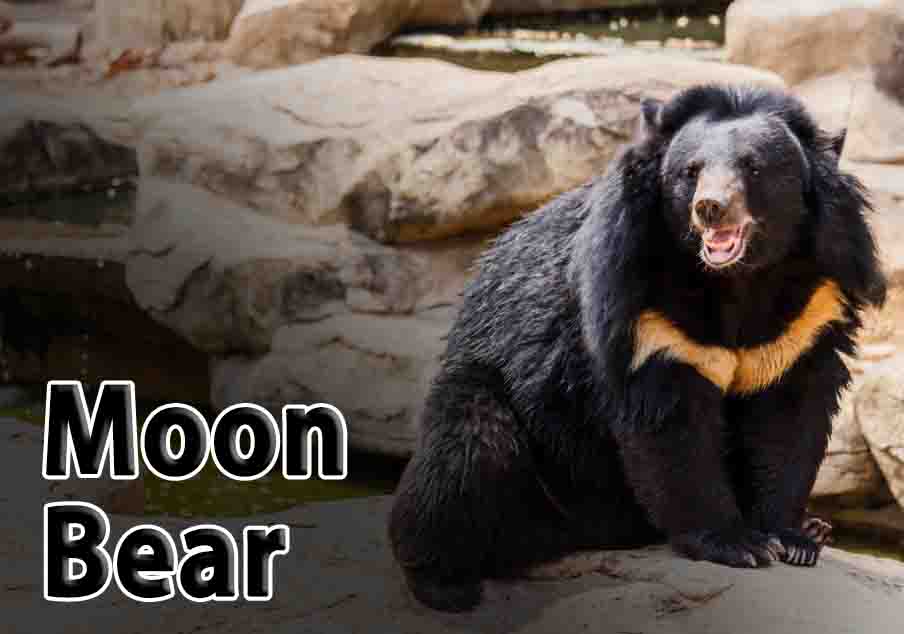The Basics
It lives in deciduous forests, grasslands, and wetlands at elevations around 11,000 feet across Asia and is mostly herbivorous. A white patch on its chest distinguishes this bear from its cousin, the American Black Bear, though it is a bit more nimble.
Insect larvae, plants and mushrooms, as well as human garbage are all common food sources for Asian moon bears like American black bears. A moon bear is typically a solitary creature, preferring to scavenge on its own rather than in groups of mothers and their offspring.
It is unfortunate that this leads to some conflict between moon bears and humans. The moon bear attacks and mauls several people every year on average. The moon bear is also thought to be more aggressive than its American cousin, according to some naturalists.
According to their hypothesis, moon bears are more aggressive because they share territory with tigers. Often, this results in moon bears attacking humans and committing revenge killings. Due to their poor vision, moon bears are also more likely to be spooked and attack.
Due to their supposed healing properties within Traditional Chinese Medicine, moon bears have a high consumer demand. The demand for moon bear parts drives a continual effort to poach these vulnerable animals, despite these supposed properties not being proven by modern science. Other threats to the moon bear include land conversion for agriculture, dams, habitat destruction, and a decreasing population.
Interesting Insights from the Moon Bear!
The moon bear displays some fascinating biological concepts that are essential to understanding, just like all of the animals we profile. The most important of these are conservation behavior, wild animal markets, and human-wildlife interactions!
Conservation Behavior
Animal behavior is a relatively new field of zoology that studies animal behaviors for the purpose of conserving them. Moon bears provide a great example of why this is so important. Human encroachment and poaching pose one of the main threats to moon bears. Similar persecution is experienced by many other large animals.
The goal of conservation behavior is to understand behaviors that lead to conflict, such as the moon bear’s desire to scavenge through human garbage and crops, in order to protect them. Conservation behaviorists may encourage farmers to plant a “protective” crop around their fields to ward off bears.
A moon bear might also be discouraged through loud noises, strong repellent scents, or other means that are in accordance with the moon bear’s natural behavior.
Wild Animal Markets
There are a variety of reasons why moon bears are sought in many countries. Moon bear bile is thought to have healing properties, while moon bear paws are revered as sacred. The cubs of moon bears are also desired as pets and carnival attractions because they can be trained in the right setting.
Many local communities in Asia are fed and supported by wild animal markets. There is, however, an increase in the demand for rare products and live animals as the population grows. In the end, consuming wild animals leads to the destruction of wild places and the extinction of animals, as humanity has already witnessed many times.
For wild animal markets to support local communities, the solution must be complex, but it must also protect humanity from potential zoonotic diseases that often originate from these markets and wild animals from overexploitation and extinction as well.
Human-Wildlife Interactions
The moon bear is often persecuted for attacking humans, like many other large animals in the order Carnivora. The fact that humans are attacked by wild animals is a tragedy, but they also deserve respect and space.
A negative human-wildlife interaction usually results in a negative public opinion of that animal. This is true even if the animal has caused much less harm to humanity than our own inventions – airplanes, for example. The public’s opinion quickly changes when an animal attacks livestock or humans.
Yellowstone National Park, for example, has been trying to reintroduce wolves and other predators. The local farmers, who are trying to protect their livestock, have resisted this effort.
Although wolves will avoid livestock as long as they have access to a wild food source, ranchers are understandably concerned for their livelihoods. As a result, conservation solutions are difficult to implement in certain areas – this will likely be true for the moon bear as well.

